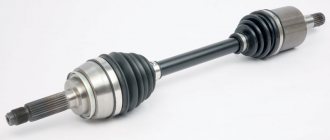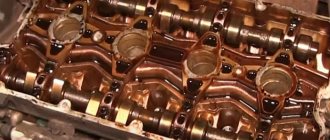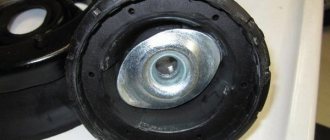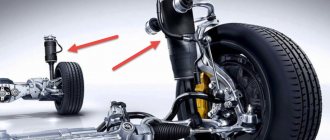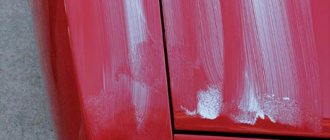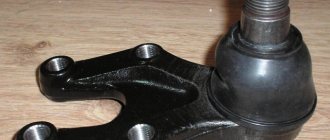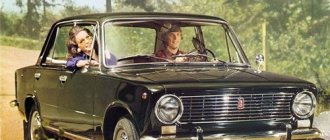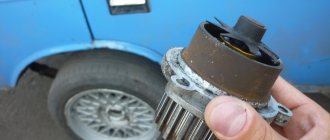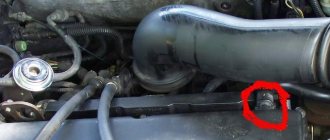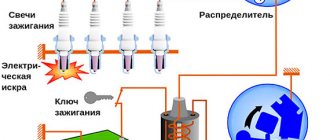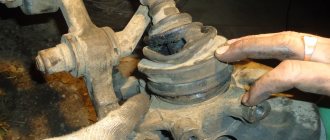KINDS
The CV joint was invented quite a long time ago; according to the most common version, it was invented back in the twenties of the last century by Alfred Rzepp. Therefore, it is not surprising that since then many varieties of this part have appeared:
- cracker - installed exclusively on trucks;
- tripod - usually used as an internal CV joint;
- twin hinge – used quite rarely due to its complex design;
- ball, or CV joint, is the most common type, which is most often used on the axles of passenger cars.
It was this invention that became revolutionary for the design of passenger cars with front-wheel drive.
CV joint device
Here you can see a photo of a ball CV joint, thanks to which it will become clearer what this part is like in the assembled state. If we talk about its components, then, in fact, there are not so many of them:
- Housing with outer ring.
- Separator.
- Inner ring.
- 6 balls.
- Shaft.
- Stop ring.
- The anthers are external and internal, they are held in place by clamps.
If you put these elements together, they actually look like some kind of grenade.
All these parts are assembled into an external CV joint and an internal CV joint. The internal one transmits rotational movements to the external mechanism, which results in a change in the angle of the axle shaft relative to the axis.
Types of CV joints, their structure and principle of operation
Modern cars use various CV joints, which are classified:
- at the installation site (external and internal);
- by type of design (ball, tripod, cam and twin cardan shafts).
External and internal CV joints
Each wheel of a front-wheel drive vehicle is equipped with 2 CV joints. The inner joint connects the gearbox and the axle shaft, the outer joint connects the axle shaft with the wheel hub. Working in pairs, they ensure transmission of torque under all types of loads.
In the most common ball joints, the outer CV joints are equipped with radius grooves that ensure uninterrupted operation of the vehicle when the wheels are turned. Internal grenades with straight grooves compensate for the movement of assembly parts along the axis when the front suspension oscillates and vehicle vibrations.
We will describe the design differences between different types of CV joints below.
Why do you need a CV joint in a car?
The need to invent a CV joint arose simultaneously with the advent of the first front-wheel drive cars. The 3 main advantages of front-wheel drive cars are well known to every motorist:
- better handling;
- efficiency.
But, when transmitting torque to the steered wheels, which were constantly changing their position, serious power losses and other negative consequences occurred:
- Conventional hinge mechanisms quickly became unusable.
- Rotation was transmitted unevenly to the wheels.
- A strong additional vibration occurred.
- The transmission shafts and gears operated under significant overloads.
The invention of the car grenade in the 20s of the last century made it possible to completely solve this complex technical problem. With the help of a CV joint, torque is transmitted to the steered wheels without loss of power or other disadvantages.
Due to its reliability and simplicity, the constant velocity joint is also widely used on rear-wheel drive vehicles that have independent suspension.
A high-quality grenade has a long service life. If you use your car carefully, the need to replace or repair it is extremely rare.
What happens if you don’t change a faulty CV joint?
During operation, a worn or damaged hinge will emit a characteristic crunching sound, which turns into loud knocking sounds when accelerating in a turn or driving through it at high speed with the car tilting.
This means that the balls become wedged and experience peak breaking loads. This will end in a breakdown and failure to transfer torque to the wheel; as they say, the drive is cut off.
The moment is very dangerous, since this can happen in a turn, where traction is critical, and a torn drive shaft can create big troubles, and a popped-out internal joint will deprive the box of its seal and it will lose oil. Without a tow truck, the car will not be able to move.
Signs of CV joint failure
CV joints belong to the category of the most reliable and durable car components. To protect against adverse impacts, the hinge joint inside the device is protected by a flexible boot. Anthers prevent dirt, moisture and dust from penetrating to the contact points of the hinge parts. When driving on well-paved roads and timely maintenance, car grenades serve the car owner for many years without repair.
Malfunctions of constant velocity joints most often occur when the vehicle is actively used on bad roads or off-road. The main reasons for failure of CV joints are:
- Damage to the boot and penetration of dirt into the hinge joint.
- Lack or use of low-quality lubricant.
- Use of defective metal or violation of technology in the production of the device.
A characteristic sign of a malfunctioning car grenade is the appearance of extraneous sounds when operating the car (a specific crunch, clicking or grinding sound). They arise due to dust or dirt particles getting into the space between the hinge elements (clips and balls). When repairing, it is necessary to replace the entire CV joint with a new analogue.
But, in general, a constant velocity joint is a device that ensures reliable, durable and efficient operation of a car. CV joints rarely become the reason for visiting a car service center.
Advice for car owners
In order to avoid premature failure of the CV joint, it is recommended to periodically visit service stations and check the tightness of the outer protective casing. If there are any defects, it is better to replace the boot along with lubricant.
If the driver hears a characteristic crunching noise while turning, it is best to immediately contact a service station. The sooner the owner changes the boot and lubricants, the cheaper the repair will be. Undoubtedly, you can move around on a faulty “grenade” for a short period of time, but with great caution. The CV joint tends to get blocked in the direction of travel, it is better not to risk the lives of passengers and the driver!
It is worth noting that if you drive too aggressively, the mechanism fails much earlier than its lifespan. The service life can only be extended by safe driving and periodic checks of the condition of the boot.
In addition, I would like to say that not all car repair technicians can detect damage to the hinge by ear. There have been cases when a car owner, after listening to an unprofessional technician, bought an expensive part and ended up out of money, because the cause of the crunching noise could be other parts of the chassis. For example, a ball joint located on the front arms, if faulty, can make similar sounds when turning the wheel.
It is best to trust your car to trusted service stations with experienced technicians!
Instructions for replacing the CV joint with your own hands.
The first thing you need to do is make marks for the general location of the inner and outer races using a marker or scriber and then follow the instructions below, I also advise you to read the article replacing a VAZ CV joint.
- First you need to hold the hinge in a vice and turn out the inner part of the cage until it stops, remove the balls in pairs. In this case, you should help yourself with a screwdriver and tap with a hammer.
- After removing all the balls, proceed to install the separator, which is placed in a vertical position, and its windows should intersect with the end of the body.
- Next, remove the fist with the separator, rotating it and at the same time retracting one of the protrusions that are located in the separator window. After this work is done, you need to separate the specified parts.
- Now you need to look through all the parts and be sure to wash and dry them. If there are no chips, wear or discoloration in the areas, then the device can still serve for some time. But one of the defects on the parts was still discovered, which means they should be replaced with new ones.
The mechanism must be reassembled only in the reverse order, but before doing this, all parts must be lubricated. This assembly begins by inserting the inner race with the separator into the outer one (here you should not forget about the marks that were placed at the very beginning). The balls are placed in pairs. The hinge must be filled with lubricant, for example, “CV joint-4”, approximately 80 - 100 grams of the product per hinge. You can also use “litol” and other similar consistencies.
Remember, you shouldn’t skimp on them, since the performance of the CV joint largely depends on the amount of lubricant you apply to it. By the way, you still need to put it in a case, 40 - 50 grams. Next we knock out the hinge along the splines, put on the boot and tighten the clamp. This is the only way the boot will ensure a good seal on the joint. In addition, when lubricating, try to rotate the CV joint so that the lubricant is distributed evenly. Well, at the very end of the assembly, experts recommend checking whether there will be strong resistance during rotation. If everything is in order, then the CV joint replacement procedure was successful.
Why does the CV joint crunch?
While operating the car, the driver sometimes hears a faint crunching sound - the crunch of a grenade. This usually becomes noticeable when the wheels are turned to the maximum angle.
Why does the CV joint crunch? What to do in such a situation?
A crunch is evidence of a unit malfunction. Initially appearing only when the wheels are turned, later it begins to appear during straight-line movement. Extraneous sounds produced by the hinge require its replacement.
It’s easy to find out which CV joint is crunching. All you have to do is leave an assistant outside, unscrew the wheels and drive off slowly. The person remaining on the street will clearly hear where the sounds are coming from.
If you perform the diagnostics yourself, you should hang up the front wheels of the car and inspect the boots. Crisp grenades can be identified by their damage.
The fact is that the cause of the crunching is usually dust and grains of sand that get into the hinge through breaks in the rubber cap. Also, a malfunction can be suspected of a unit on which greater play was detected than on all other hinges.
Constant velocity joint device
Since we are interested in the ball joint, we will consider its structure. Due to the fact that the elements are not in oil (unlike the rear axle), the device is called “dry”. The design of the ball joint is quite simple.
What does a CV joint consist of:
- Frame. It is a hemisphere, a bowl. The driven shaft is installed in it.
- Bottom part. This is a sphere-shaped cam with a drive shaft.
- Separator. This is a ring with holes into which metal balls are installed and held there.
- Metal balls. Movable elements. There are 6 of them.
Malfunctions and repairs
You can determine that a unit requires replacement by characteristic clicks, similar to the blows of a small bumper.
Typically, the picture of node death is as follows:
- When turning 90 degrees and sharply pressing the gas, loud dull clicks appear to the right or left of the driver (whichever side the sound comes from is where the malfunction is hidden). When starting sharply, driving in a straight line and changing lanes, there are no extraneous sounds yet;
- If you continue to drive without eliminating the defect, the knocking will intensify and occur when you press the gas, even with slight turns of the steering wheel, and then even when starting off and driving straight;
- Jamming and "explosion". The hinge housing or separator bursts and the car loses the ability to move independently. This can seriously damage parts of the engine, suspension and braking system. By the way, such consequences occur extremely rarely. More often than not, it ends in simple immobilization.
The separator in this grenade burst and the balls simply fell into the boot, depriving the car of a chance to move.
So here is the answer to the question “what is a grenade in a car?” - it turns out that this spare part, like its explosive namesake, can “bang”, disabling it and causing damage.
Interestingly, the spare part is not repairable. Therefore, even if the disease is detected in the early stages, it will have to be completely replaced.
Which CV joint to choose
Before buying a new CV joint, you should find out about the types (what they are), which ones are better according to driver reviews, and what the prices are. The main emphasis should not be placed on the price when purchasing this element of the car device.
There are the following companies that produce CV joints:
- Pilenga. According to reviews, it's a good option.
- Febest. According to reviews from drivers who bought spare parts from this company at an inexpensive price, they quickly break down.
- Metelli. Recommended.
- Loebro. Recommended.
- SKF. Recommended.
The characteristics of CV joints are different. There are 23 splines in the design, and there are 24. If you make a mistake, the wrong one (the difference is one tooth) will not fit on the shaft.
On the list, the last three brands have proven themselves well and have been tested. There are disadvantages with the anthers from the Metelli company, namely, the anther is poorly fixed. In Loebro, the anther is also a weak link. The third type of SCF created its high rating due to the high quality of the bearings they produce. SKF CV joint life = 100 thousand km. provided that the anthers are in good condition and the car is operated in a quiet mode. When using a car, squeaks often occur. It is usually the stabilizer bushing that creaks, the service life of which is usually 30 thousand km. I advise you to look at how to change stabilizer bushings.
A high-quality new spare part differs from a new one in appearance and feel. A defective CV joint has a thin boot, little lubrication, and a weak clamp securing it.
conclusions
From what is described above, it becomes clear that CV joints are an indispensable structural element of a vehicle. The consequences of operating a car with a failed part can be disastrous - there is a high risk of the wheels jamming and, as a result, creating an emergency situation on the road.
Replacing hinges is a very expensive pleasure, but it must be done on time, because if this structural element is destroyed, its remains may end up in the gearbox, which will entail the need to repair two expensive components.
How does a CV joint work?
When studying how the CV joint works, we recommend that you conduct a thorough inspection of this device.
Guided by special literature, you will probably be able to find more than just a detailed description of the operation process of the CV joint we are considering today:
- Spherical grooves, which are provided in the body, as well as on the inner race, and the number of which exactly matches the number of balls.
- The balls, which are located in the space between the body and the so-called fist, are held by a special separator.
- In the case of rotation of the drive shaft, the force will be transmitted through the fist to the holder and then to the driven shaft.
- If the angle between the drive and driven shafts changes, the balls will be able to move freely along certain grooves, continuing to gradually transmit force.
Service life and maintenance
A grenade in a car is a consumable item. It will have to be changed quite often. Fortunately, the cost of the unit and repairs is usually not the highest.
How much a factory part costs depends on three factors:
- Driving manners;
- Machine models;
- Timely service.
The first factor is critical. Grenades are especially afraid of the trigger falling down when the steering wheel is turned to the extreme position. At such moments the node experiences maximum load.
If you mostly move calmly, then you can look for a resource for your car on thematic forums. There are cars in which a standard product can cost more than one hundred thousand.
Timely maintenance means periodic inspection of the boots, their timely replacement and filling with lubricant. If a crack appears in the rubber, the death of the CV joint will occur in just a couple of weeks. And in rainy weather this can happen even faster. This is due to water, which, when it gets into the assembly, leads to corrosion and leaching of the protective lubricant.
Surely you will be interested to know that in addition to grenades, absolutely all ordinary cars have a TV! Be sure to read our article on this so you can be a knowledgeable car owner.
A torn boot is a typical malfunction.
Boots, by the way, are quite inexpensive. The lubricant is also cheap and is called tritely - “CV joint”. When purchasing, do not forget to check that the anthers come with clamps for tightening them.
Advice on how to extend the life of a grenade:
- Do not press the pedal to the floor when turning, especially when starting off
- Change boots and lubricant in a timely manner
The lifespan of external and internal grenades is very different. The first is subject to great effort, since it is forced to turn at significant angles, and therefore makes itself felt more often.
The internal part may well not be bothered for the entire service life of the car.
How much do car grenades and drives cost and where is the best place to buy them, where to buy an internal grenade
One new external grenade costs about 1,700 rubles. Since internal grenades very rarely fail, it is almost impossible to buy them in a store. If the internal grenade has become unusable, then you should buy a contract drive assembly (as in the first photo, at Yukka Motors a drive with grenades costs about 2,000 rubles).
Replacing the drive, like one of the grenades, costs 600 rubles and takes about half an hour. When replacing the drive, the oil is drained from the box.
Contract drives last quite a long time; with quiet driving, they can last 2–3 years.
Rules for the safe operation of CV joints (Grenade)
The front wheel joint operates in difficult conditions - dirt, water and reagents fly from the road. The bearing housing is closed with a corrugated rubber coupling (boot). If the boot is damaged, dirt will get into the joint and begin to destroy the race, balls, and eventually the wheel will jam. If this happens at speed, the question of what a CV joint (Grenade) is in a car and how much it costs will be irrelevant, the body will be written off.
Therefore, if small tears or traces of grease appear on the corrugation, you should immediately contact service. come back
